

THE STORY
Owner Rosie Foster (above) owns the house. When she and husband Simon are not using the cottage themselves, Apifera is available as a holiday let (uniquehomestays.com).
Property A quarry worker’s cottage, originally built in the 1600s. The cottage overlooks the Wye Valley in Herefordshire. It was adapted in the 1800s and was extended more recently by the previous owners.
What she did Removed all the dry lining and plastic sheets from the walls and repaired them using lime and traditional building methods. Replaced modern kitchen tiles with reclaimed quarry tiles and used salvaged roof boards to create a hayloft above the kitchen-diner.
Plain and simple, its interiors capturing the essence of humble 1930s and 40s style: this was what Rosie Foster had in mind as she started renovating her small rural cottage. It soon became clear, however, that the project would be anything but simple and Rosie had to rethink her plans for the interiors once she realised the scale of the work ahead.
She had never intended to take on such a huge renovation. ‘When I told my husband I was going to look at this cottage he said: “you’re totally mad” and he was totally right in hindsight!’ says Rosie. ‘But as soon as we came up the track I just fell in love with the cottage.'
Read on to find out how this restoration developed into something far more complicated, as Rosie and her builder uncovered structural problems that required urgent attention. Then browse all our real home transformations. For more information about how to renovate a house, see our expert guide.
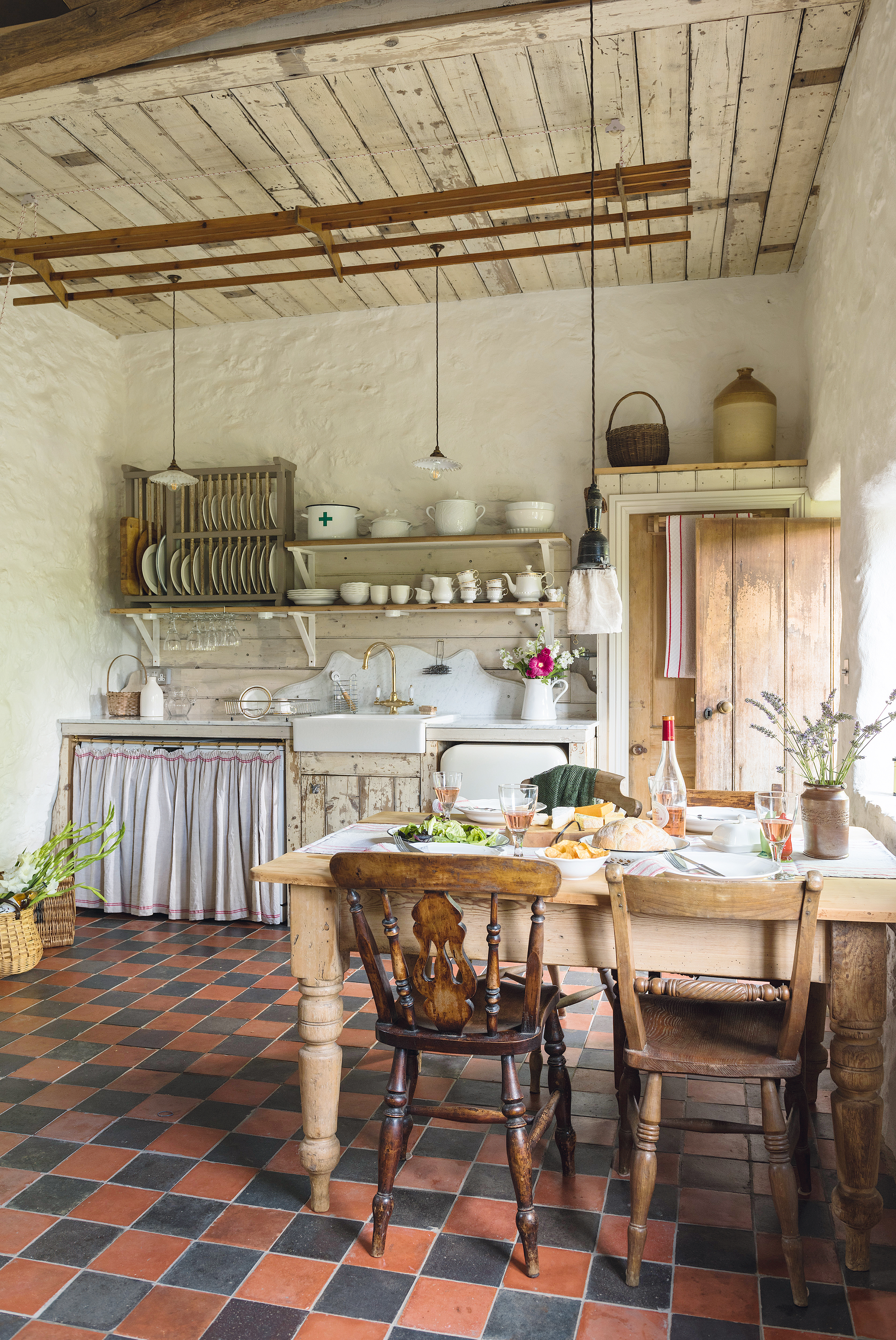
To save money, Rosie sourced roofing boards from a Welsh reclamation yard to clad the ceiling and create a hayloft. She had to remove all the nails and clean each one before builder Anthony Feakins could fit them. He also made the kitchen cabinets from leftover roofing boards. A dishwasher is hidden behind a country-style French linen curtain
In an idyllic setting with its own grapevines and cider orchard, surrounded by almost seven acres of common land overlooking the River Wye, it is one of 30 or so quarrymen’s cottages dotted across the hill. The cottage appealed not only because of the glorious scenery, but also because it seemed untouched by the modern world. 'It was perfect – or so we thought,' says Rosie.

The extra work to repair the kitchen’s walls and ceiling used up most of Rosie’s budget. Her response was to get creative, using and upcycling salvaged materials. The floor tiles had been in the garden for 20 years, picked up when a derelict bothy was being renovated nearby. Husband Simon spent hours with an angle grinder cleaning lime mortar off them. A super-efficient Pyroclassic Fire heats the water and the cottage
‘All but one of the other cottages on the hill are surrounded by extensions, but this one hadn’t been tampered with too much,’ says Rosie. The house was altered by its Victorian owner in the 1800s, when the flagstones were replaced with floorboards and a smart stone fireplace replaced the rough-hewn chimney opening and bread oven. Partition walls were added upstairs and downstairs, so the modest one-up one-down dwelling went up in the world.

The oven is a Neff Variosteam, and the unusual marble splashbacks behind the hob and the sink came from old Victorian washstands
Subsequent owners incorporated the adjacent barn to create a kitchen and had dry-lined the walls in an effort to make the cottage warmer; this had caused a lot of damp. ‘I knew there was something wrong,’ says Rosie. ‘The bathroom wall was damp and badly bowing into the room.’

The living room provided welcome respite from the building work, as relatively little had to be done to bring the room up to scratch. The walls were painted, and a few rotten floorboards had to be replaced – the newer narrower boards are concealed under the rug, while the old wide ones are in more visible places. Originally, the fireplace would have been stone and much more rustic, but this dressed stone surround was added in 1831. The sofa was Rosie’s mother’s and a friend reupholstered it. The armchair belonged to Rosie’s great-aunt
Rosie was keen to get the kitchen up to scratch, but the structural engineer had said the ceiling joists were not suitable for weight bearing. ‘We decided to remove and replace them with the correct load-bearing joists before replacing the ceiling,’ says Rosie. ‘We could then come back to the room above the kitchen at a later date.’
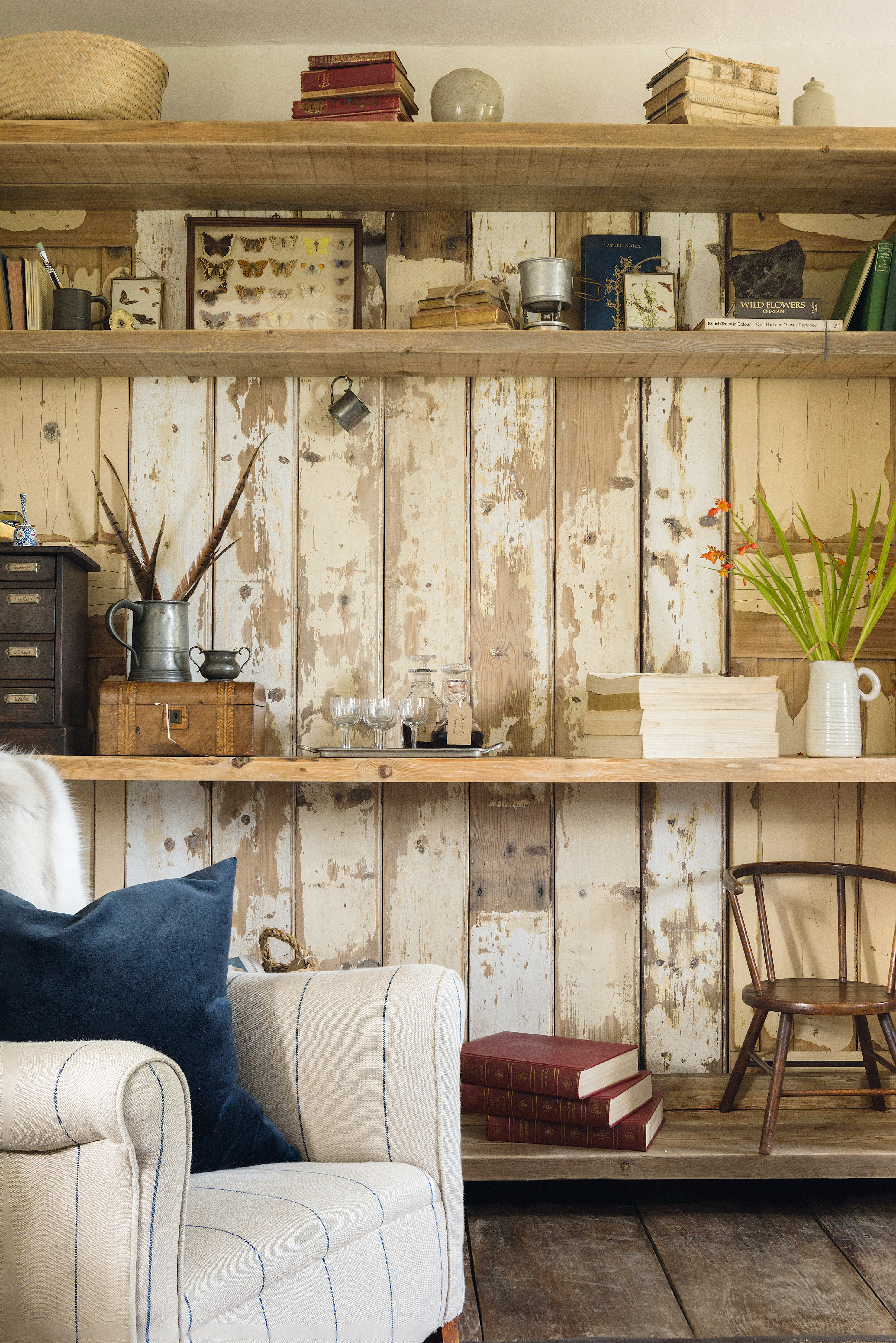
Simon and Rosie made the bookcase in the living room by cutting a door in half, and filling in the gaps with leftover planks
Work started with the help of local builder Anthony Feakins and the ceiling was removed. It soon became apparent that all was not well. ‘The truss was balancing on a single stone set in the wall, the roof wasn’t attached to the truss, and the weight of the roof was causing the walls to bow,’ recalls Rosie. ‘A lot of the mortar within the old walls had long been washed away. It was our worst nightmare. We couldn’t sell it in this semi-derelict state, the only way was to forge ahead.’

The hall was created in Victorian times, when a partition wall divided up the space to isolate the staircase
MORE FROM PERIOD LIVING
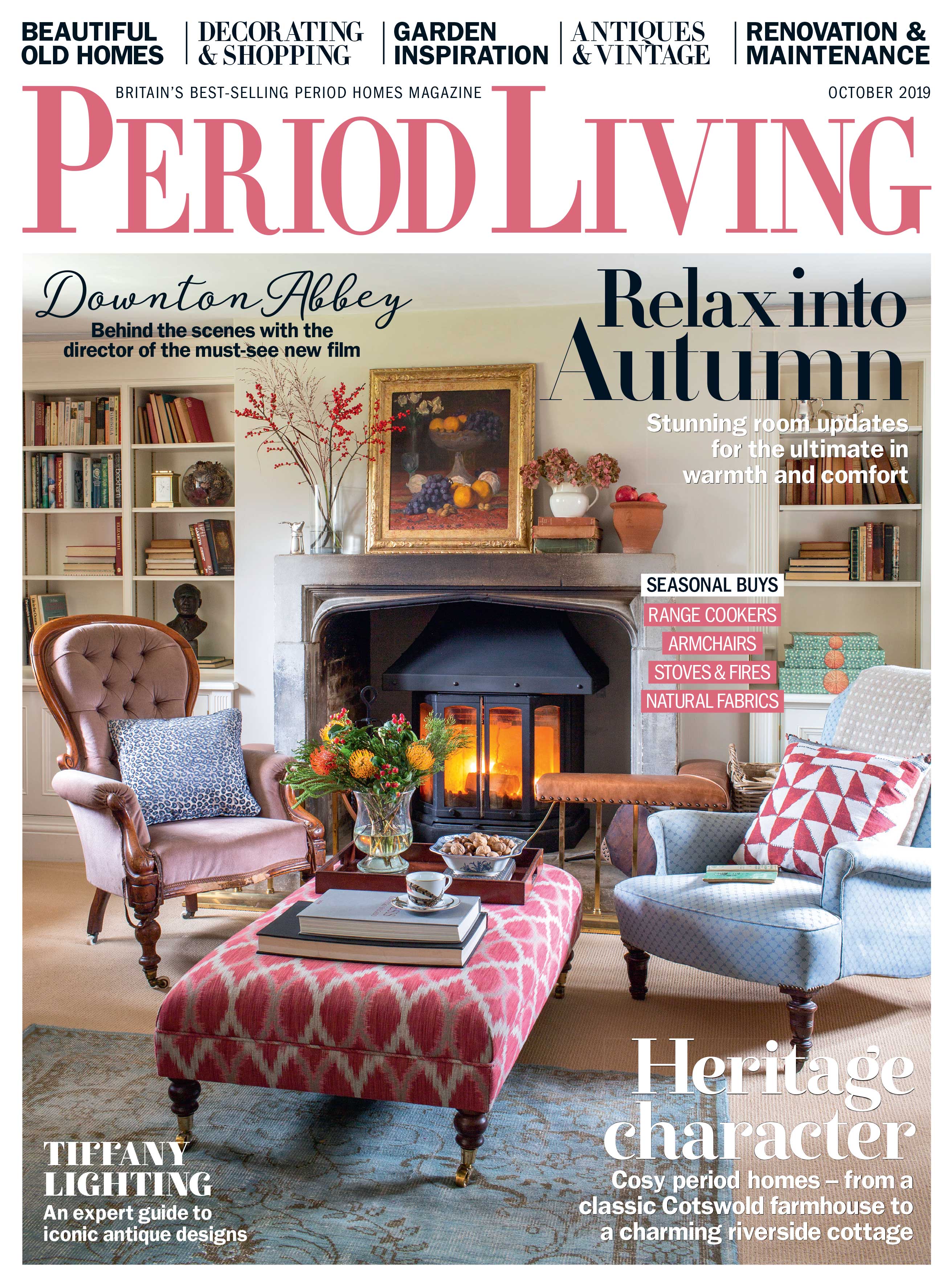
Get the best period home inspiration, ideas and advice straight to your door every month with a subscription to Period Living magazine
A less courageous renovator might have crumbled – along with the walls – but Rosie, putting a characteristically positive spin on the challenge, decided it would bring the kitchen closer to its original use as a barn.
‘We pulled off what remained of the old plaster and got to the plastic lining,’ she adds. ‘It was so depressing, everything was sopping wet and water was streaming down the walls. It really was my lowest point.’
Luckily builder Anthony kept things on track, telling Rosie that it was a limestone cottage and that lime needs to breathe.
‘He told me we had to get rid of the plastic lining, so we took it off, and went home,’ says Rosie. ‘The next morning we got up there really early, and it was as dry as a bone. It had completely dried out in just one night.’
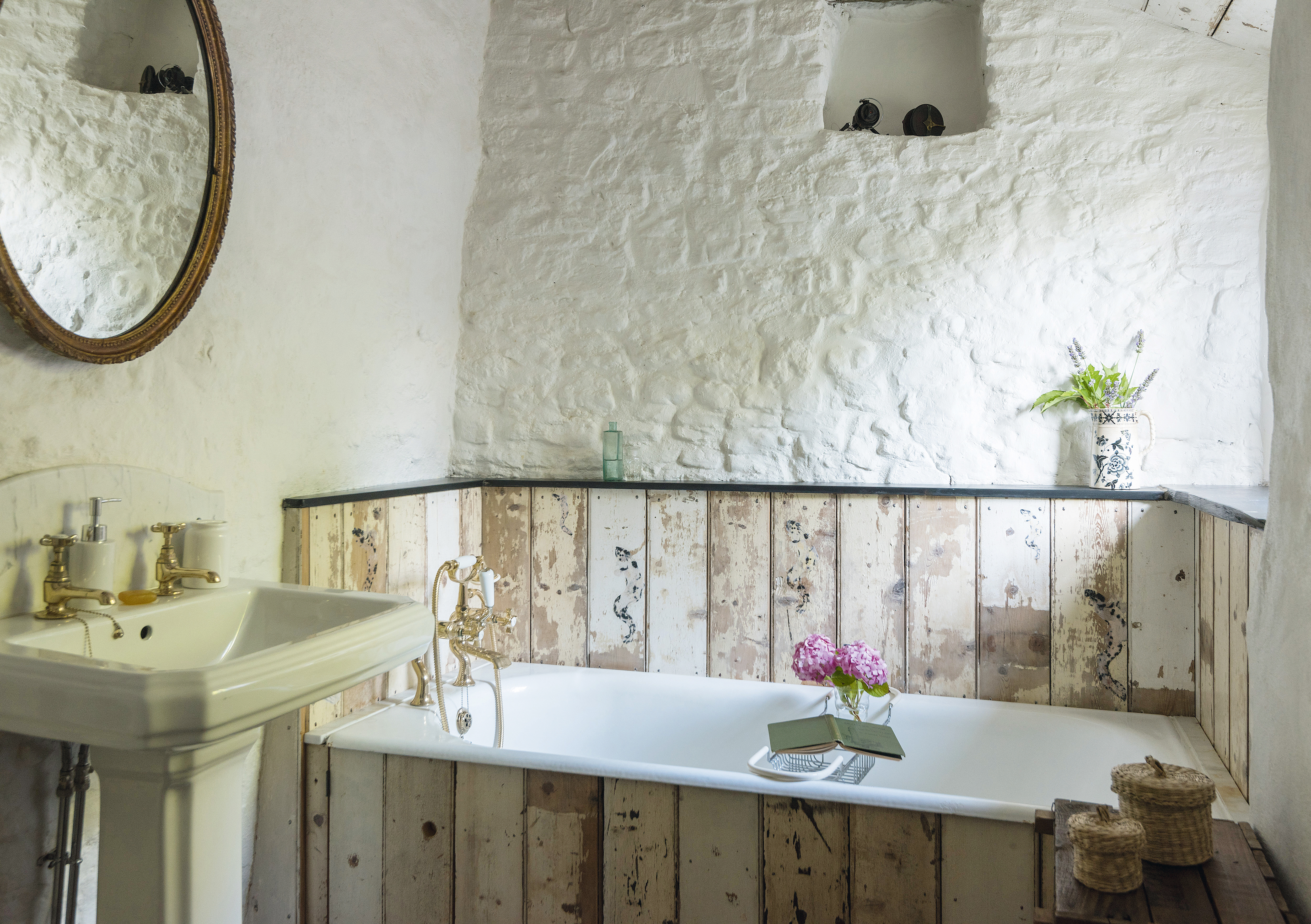
The bathroom walls were damp and had to be repaired with lime mortar. Rosie had already banished the old bath to the garden, intending to replace it, but when costs soared, she brought it back in, adding taps donated by a friend More reclaimed roofing boards have been used as panelling
From that moment on, the renovation became all about putting the cottage back in touch with its humble beginnings. Using natural and traditional materials – lime mortar and clay paints, reclaimed tiles and timber – and secondhand and antique furnishings, Rosie transformed the cottage into the calm space it is now.
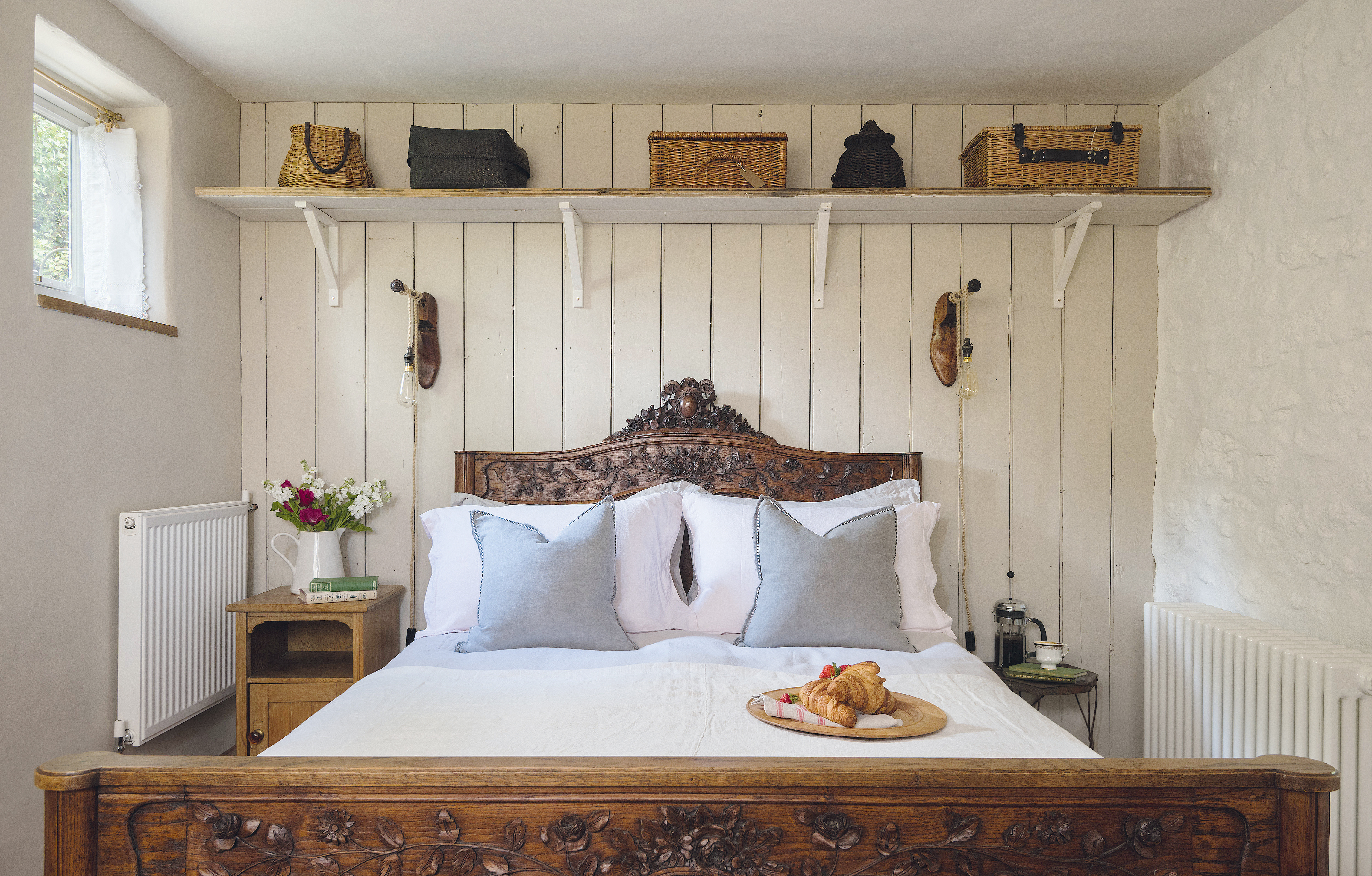
An extension created by the previous owners made an extra downstairs bedroom. Rosie exposed the original outside wall to blend the new room with the old house and painted and fixed old roofing boards behind the bed. The antique French marriage bed is an Ebay find with linen from Soak & Sleep. The French wire table is from Bailey’s
Her thoughts of post-war interiors with spriggy floral fabrics changed to reflect the more rustic look of the kitchen, and she opted instead for a traditional Welsh cottage look.
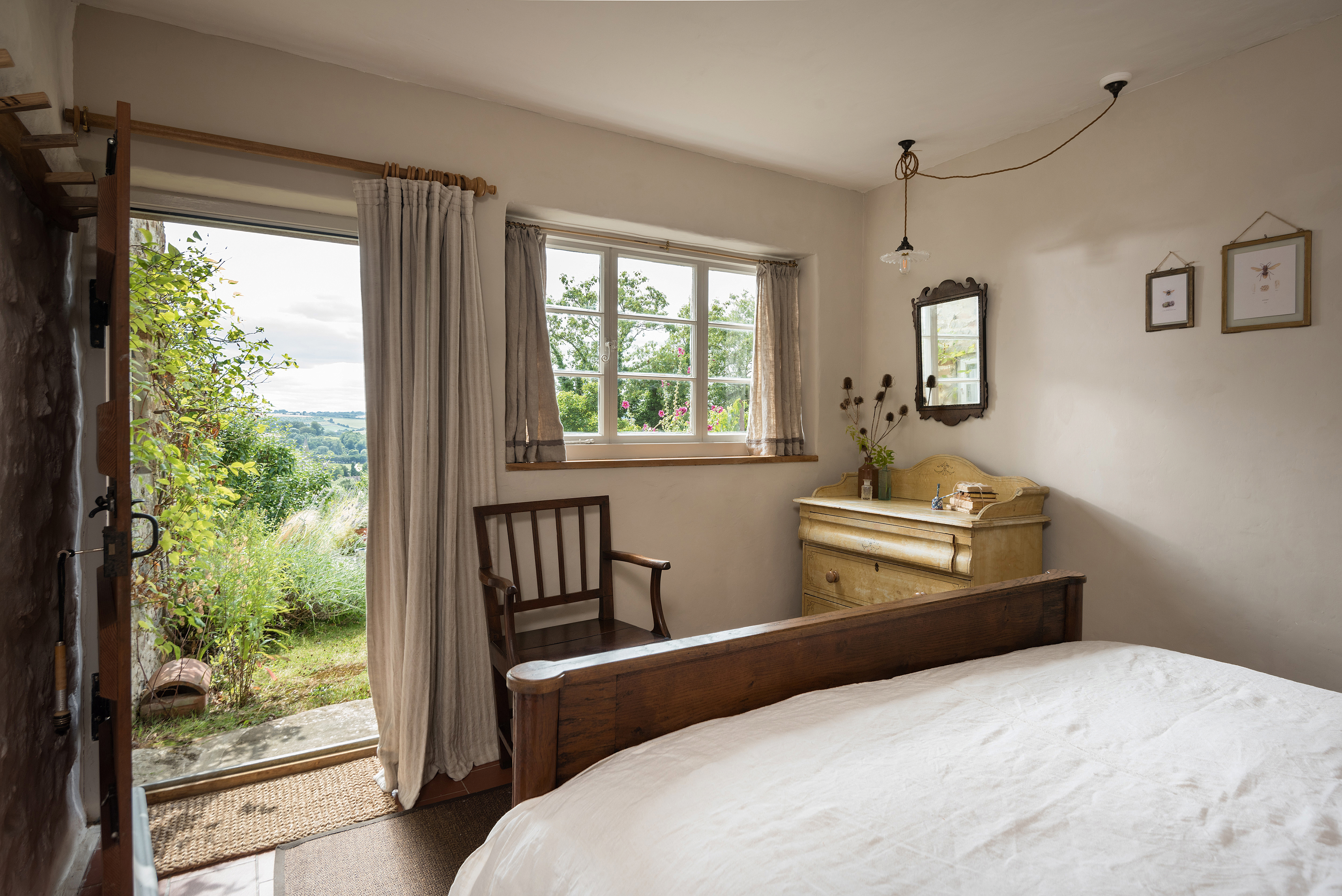
The downstairs bedroom has its own door into the garden with views across the Wye Valley
Rosie’s husband Simon and their son Max pitched in to help, cleaning all the old quarry tiles and lime rendering the interior walls. Rosie scoured the local area sourcing materials for the build and cleaned and sanded old roofing boards one by one.
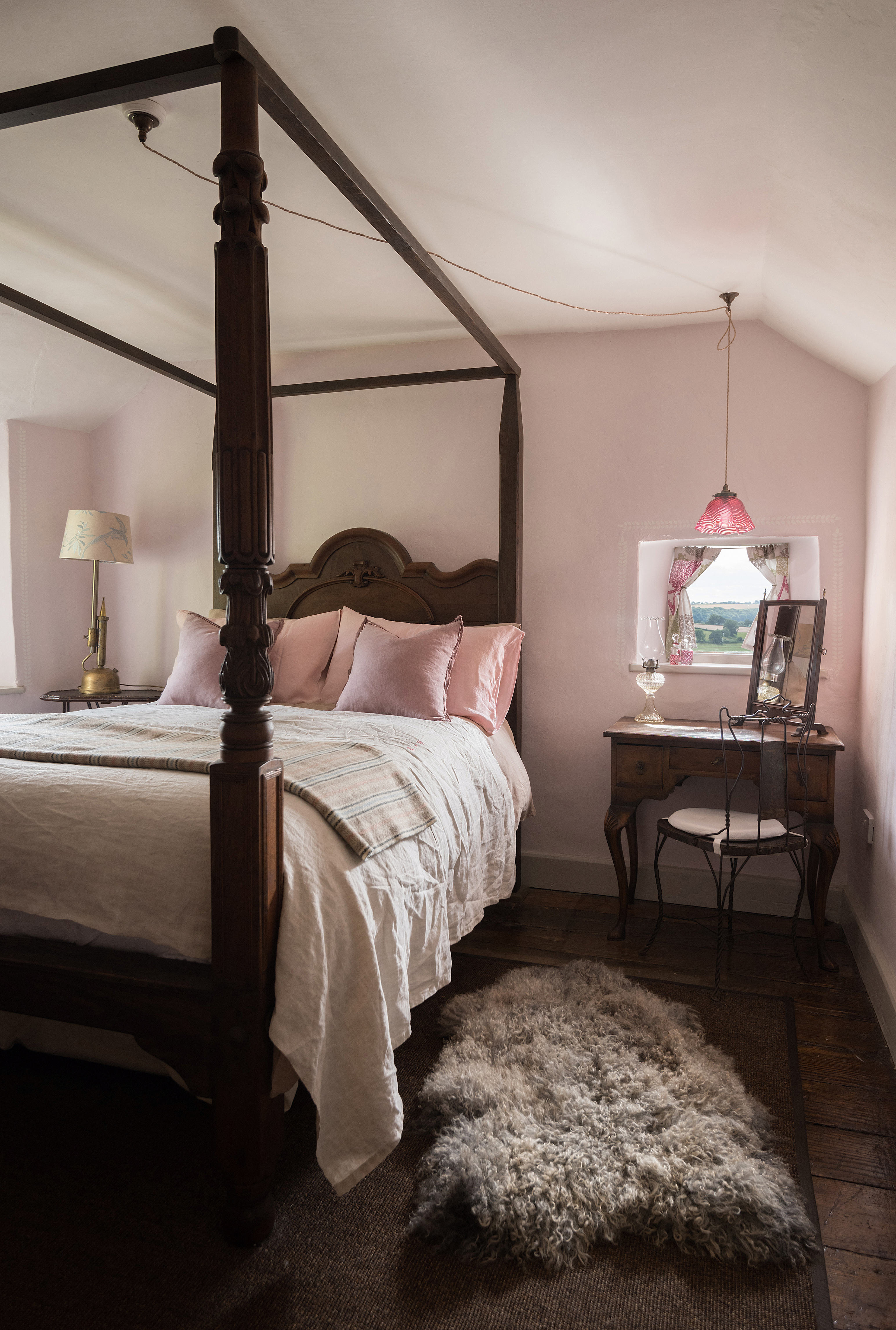
The four-poster has been put together by combining a 17th-century English foot post with a Victorian headboard
The additional building work on the kitchen and walls took care of Rosie’s budget, so by necessity the finishing touches have an element of make-do-and-mend. Bookcases were fashioned from an old door and some scaffolding planks, antique tray cloths became curtains, and the bath that had been removed because Rosie thought it looked ‘a bit tatty’ had to be put back in again, with taps donated by friends.
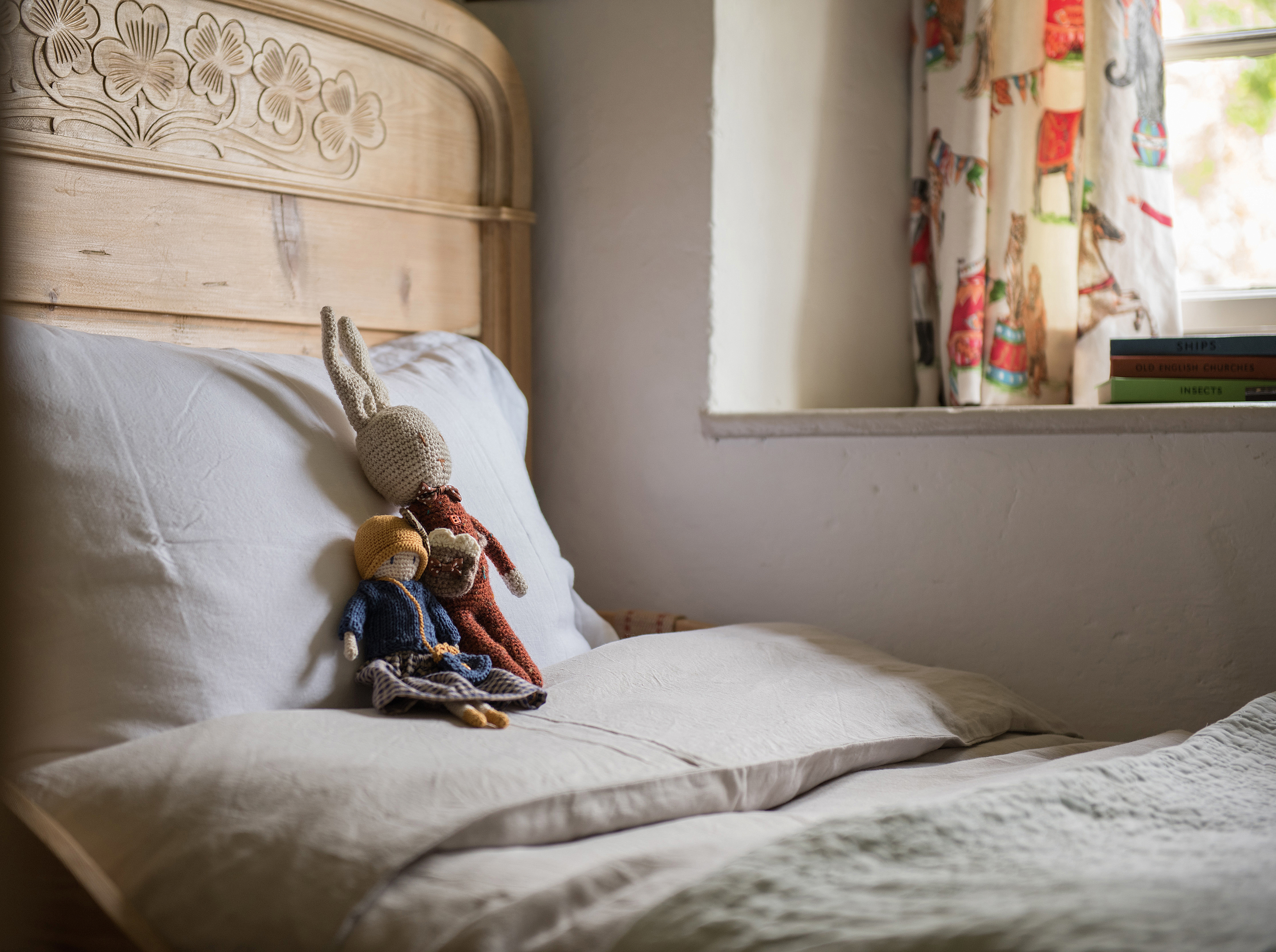
A Welsh pine bed is the star in this child’s room, with curtains made in colourful Circus fabric, bought from Tinsmiths in Ledbury
It took Rosie just one year to complete the renovations. A relentless year of shifting rubble, working through clouds of dust and piles of salvaged timber. ‘It took over our lives, every weekend, every single day,’ recalls Rosie. ‘We didn’t see anyone or do anything. We had to get it finished, we had to get it up and running.’
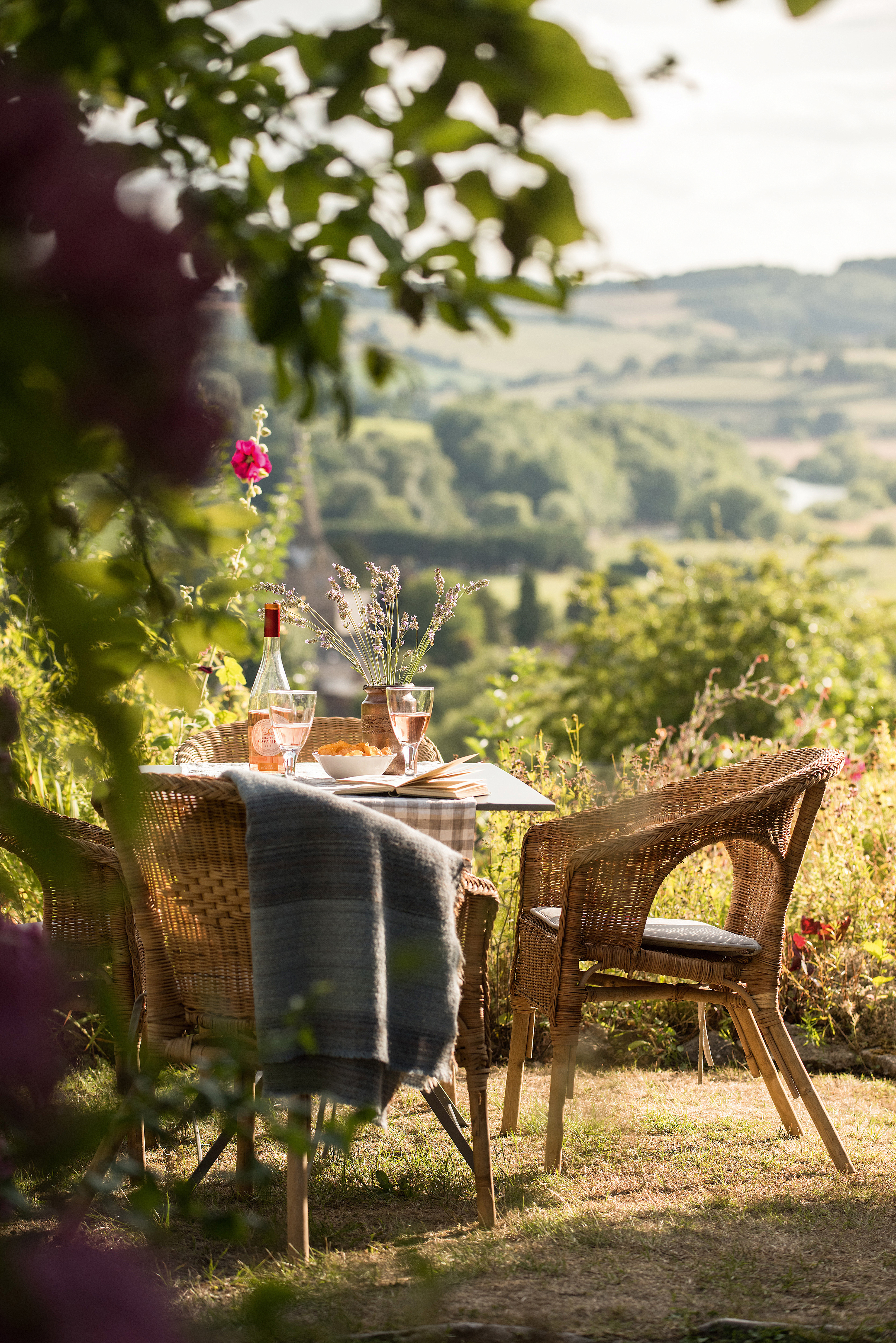
Once the house was finished, Rosie and Simon found time to bring the garden back under control, creating two new seating areas with fabulous views all round
Yet despite all the hardships, the results are quiet and harmonious, with no hint of the traumas Rosie and her cottage have endured along the way.
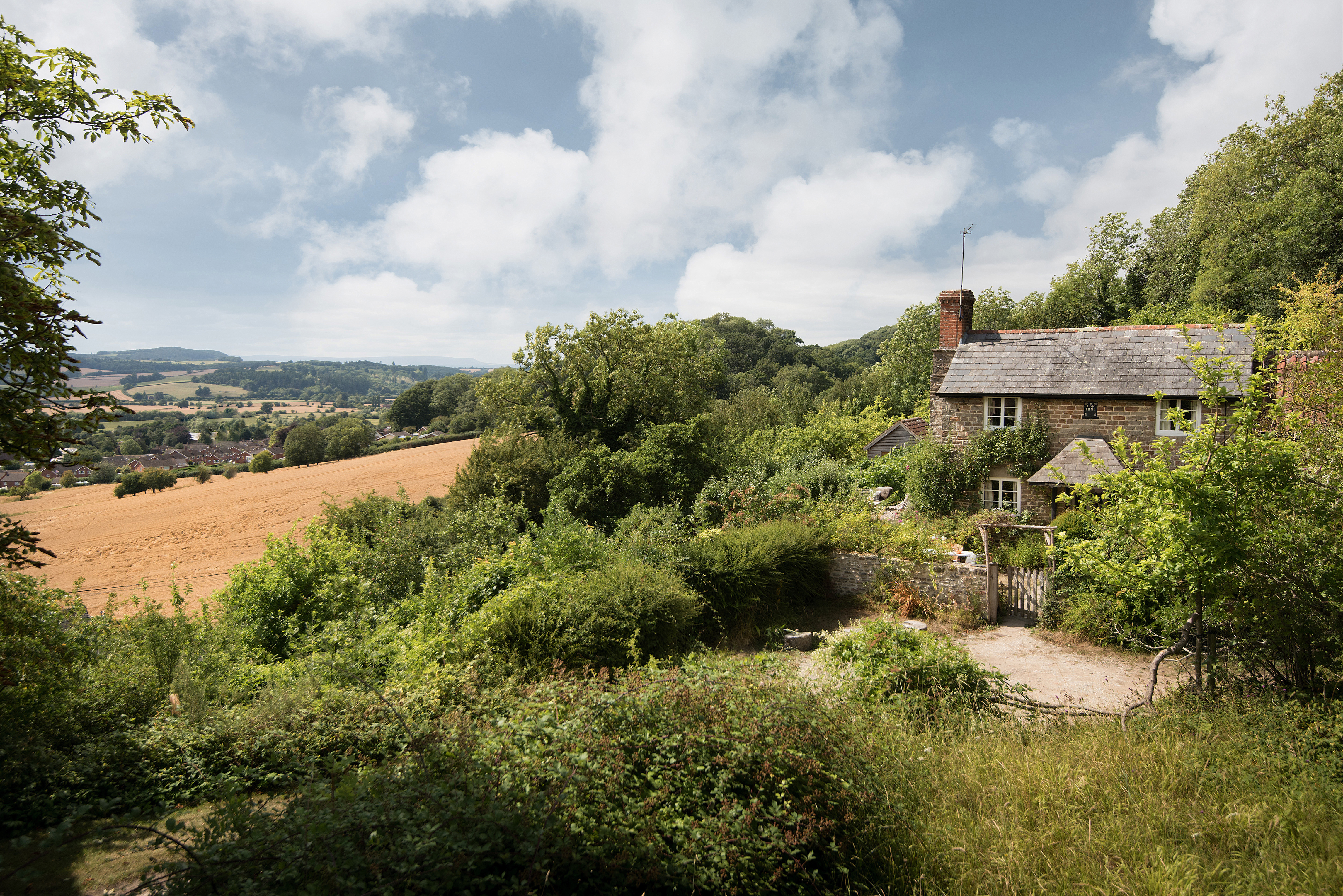
Overlooking the River Wye, Apifera is one of around 30 or so cottages scattered across the hillside, built with a mix of Forest of Dean and Herefordshire stone by the workers who quarried it from the lime ridge. The cottage dates back to the 1600s, and was extended and altered in Victorian times
‘It was full on but it was a joy. I’ve loved seeing it all coming together from that awful disaster moment, when water was pouring down the walls,’ says Rosie. ‘Suddenly it all worked, it was extraordinary. As soon as we took down the ceiling and took out the plastic and breeze blocks the whole place took on a different feel. It’s as if the house was saying “thank you, I can breathe again”. And I’d do it all again in a flash if I could.’
Photographs David Curran for Unique Home Stays

This outdoor seating area is sheltered by its own grapevines and cider orchard, and is the perfect spot to enjoy glorious views of the Wye Valley. Rosie and Simon made the rustic garden furniture from a neighbour’s felled poplar tree
More rustic country cottages
Join our newsletter
Get small space home decor ideas, celeb inspiration, DIY tips and more, straight to your inbox!
-
 This colourful home makeover has space for kitchen discos
This colourful home makeover has space for kitchen discosWhile the front of Leila and Joe's home features dark and moody chill-out spaces, the rest is light and bright and made for socialising
By Karen Wilson
-
 How to paint a door and refresh your home instantly
How to paint a door and refresh your home instantlyPainting doors is easy with our expert advice. This is how to get professional results on front and internal doors.
By Claire Douglas
-
 DIY transforms 1930s house into dream home
DIY transforms 1930s house into dream homeWith several renovations behind them, Mary and Paul had creative expertise to draw on when it came to transforming their 1930s house
By Alison Jones
-
 12 easy ways to add curb appeal on a budget with DIY
12 easy ways to add curb appeal on a budget with DIYYou can give your home curb appeal at low cost. These are the DIY ways to boost its style
By Lucy Searle
-
 5 invaluable design learnings from a festive Edwardian house renovation
5 invaluable design learnings from a festive Edwardian house renovationIf you're renovating a period property, here are 5 design tips we've picked up from this festive Edwardian renovation
By Ellen Finch
-
 Real home: Glazed side extension creates the perfect garden link
Real home: Glazed side extension creates the perfect garden linkLouise Potter and husband Sean's extension has transformed their Victorian house, now a showcase for their collection of art, vintage finds and Scandinavian pieces
By Laurie Davidson
-
 I tried this genius wallpaper hack, and it was perfect for my commitment issues
I tried this genius wallpaper hack, and it was perfect for my commitment issuesBeware: once you try this wallpaper hack, you'll never look back.
By Brittany Romano
-
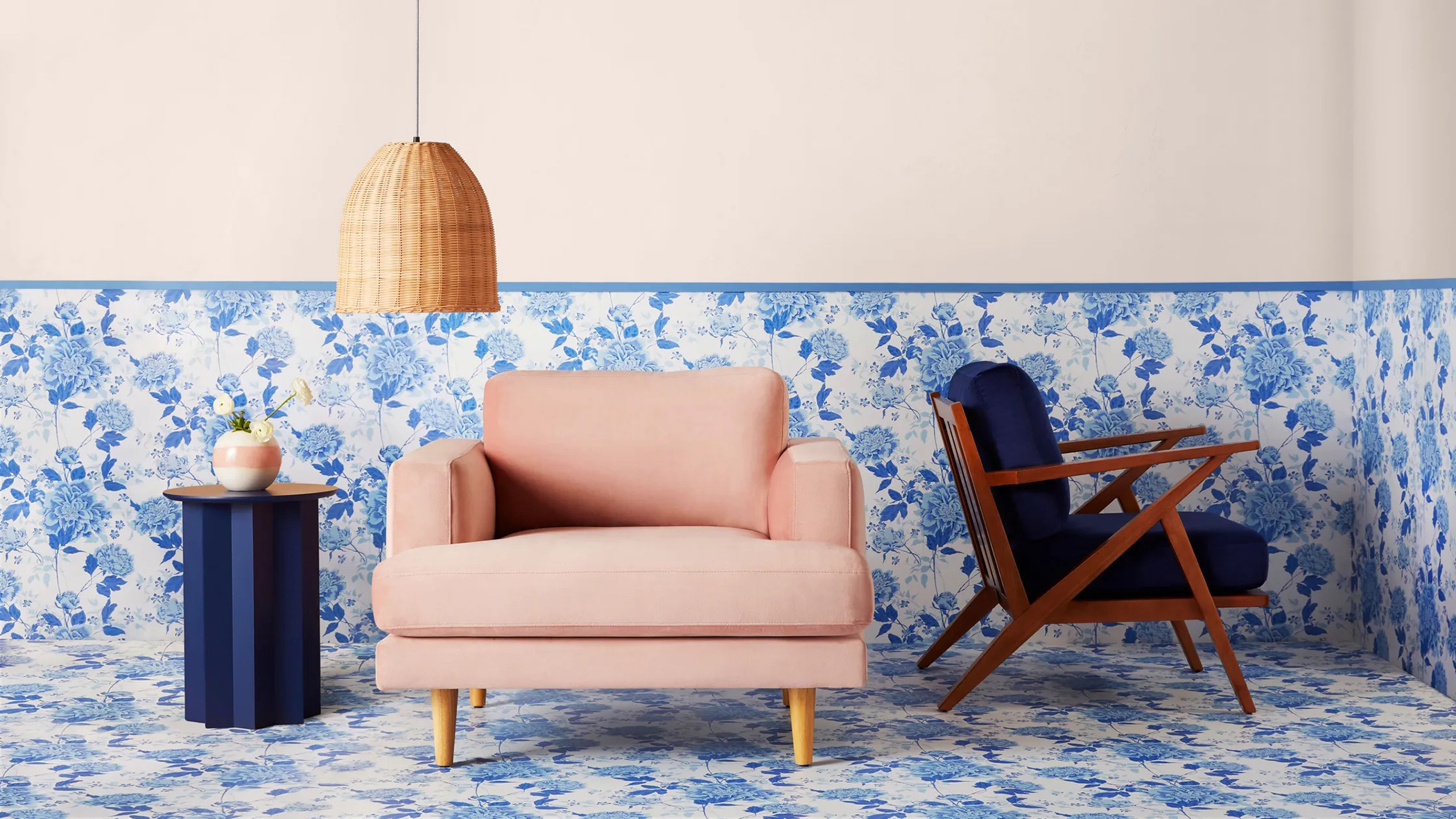 Drew Barrymore's new FLOWER Home paint collection wants to give your walls a makeover
Drew Barrymore's new FLOWER Home paint collection wants to give your walls a makeoverDrew Barrymore FLOWER drops 27 brand-new paint shades, and every can is made from 100% post-consumer recycled plastic.
By Brittany Romano